Difference between revisions of "User:Heritagefutures"
(→Lens and shutter combinations) |
(→Lens and shutter combinations) |
||
| Line 448: | Line 448: | ||
==Lens and shutter combinations== | ==Lens and shutter combinations== | ||
* [[Kajiro_Kōgaku|K.O.L.]] Special f/3.5 75mm | * [[Kajiro_Kōgaku|K.O.L.]] Special f/3.5 75mm | ||
| − | **in WESTER-MODEL-I shutter (T, B, 1-200th)<ref>Illustrated on the back panel of a [http://www.flickr.com/photos/heritagefutures/5254049972 Brochure (1943?) on the Mamiya Six III]</ref> | + | **in [[Nishida shutters| WESTER-MODEL-I]] shutter (T, B, 1-200th)<ref>Illustrated on the back panel of a [http://www.flickr.com/photos/heritagefutures/5254049972 Brochure (1943?) on the Mamiya Six III]</ref> |
*T.S.M. Anastigmat f/3.5 75mm | *T.S.M. Anastigmat f/3.5 75mm | ||
**in [[Olympus|OLYMPUS]]-TOKYO-N KOHO shutter (B, T, 1-200th)<ref> sn#22344—Photographica Collection Dirk HR Spennemann </ref> | **in [[Olympus|OLYMPUS]]-TOKYO-N KOHO shutter (B, T, 1-200th)<ref> sn#22344—Photographica Collection Dirk HR Spennemann </ref> | ||
Revision as of 22:00, 17 December 2010
Contents
- 1 Collection Interests (eclectic)
- 2 Websites
- 3 TO DO
- 4 Resources
- 5 MY SANDBOX
- 6 PAGE ONE -- MAIN ENTRY FOR MAMIYA-SIX
- 7 History
- 8 Patent Application
- 9 Notes
- 10 PAGE TWO -- Mamiya Six I
- 11 Mamiya Six Ia
- 12 Manuals, Brochures and Advertisements
- 13 Notes
- 14 PAGE THREE -- Mamiya Six II
- 15 Mamiya Six IIa
- 16 Brochures and Manuals
- 17 Notes
- 18 PAGE FOUR -- Mamiya Six III
- 19 War-time version
- 20 Post war versions
- 21 Brochures and Manuals
- 22 Advertisements
- 23 Notes
- 24 PAGE FIVE -- Mamiya Six IV
- 25 PAGE SIX -- Mamiya Six V
- 26 Notes
- 27 PAGE SEVEN -- Mamiya Six K
- 28 Notes
- 29 PAGE EIGHT -- Mamiya Six IVb
- 30 Notes
- 31 PAGE NINE -- Mamiya Six Automat
- 32 Patent Application
- 33 Notes
- 34 PAGE TEN -- Mamiya Six K2
- 35 Notes
- 36 PAGE ELEVEN -- Mamiya Six IVs
- 37 Notes
- 38 PAGE TWELVE -- Mamiya Six P
- 39 Notes
- 40 PAGE THIRTEEN -- Mamiya Six Automat 2
- 41 Notes
- 42 PAGE FOURTEEN -- Mamiya Six Design Variations
- 43 Notes
Collection Interests (eclectic)
- Simmon-Omega/Koni-Omega/Koni-Omegaflex/Rapid Omega family of cameras
- Japanese aerial and other military cameras
- Foth & Co cameras and binoculars
- Konica model I cameras (variants)
- Cameras with Gitzo Shutters and Gitzo gear (older stuff preferred)
- Konishiroku and Rokuoh-sha (not systematic)
- Mamiya Six cameras (variants)
Websites
TO DO
Photograph:
- door catches of the two Six III versions
- door shape of the two Six III versions
Resources
six-pane documentation

|

|

|

|

|

|
| Mamiya Six Model XXXXXX. Images by Dirk HR Spennemann. (Image rights) | ||
right float image

|
| CAPTION CAPTION CAPTION Image by Dirk HR Spennemann. (Image rights) (Image rights) |
MY SANDBOX
[1]
PAGE ONE -- MAIN ENTRY FOR MAMIYA-SIX
This article is about the spring-folder camera made by Mamiya in the 1940s and 50s. For the 1990s camera, see Mamiya 6.
The Mamiya Six is a series of 6×6 folders with a coupled rangefinder, made by Mamiya from 1940 to the 1950s. All of them are focused by moving the film plane, rather than the more common front-cell focussing of other folders of the time.
History
Seiichi Mamiya's camera design departed from the common method of front cell focussing. In order to be able to control the camera while maintaining a firm hold, he designed a method that allowed the film plane to move in relation to the lens. He filed his invention on 1 July 1939 in Japan[2] and on 5 June 1940 in the U.S.A. The U.S. Patent (nº 2,305,301) was granted on 15 December 1942, but, because of the state of war between the USA and Japan, was vested in the Alien Property Custodian.[3]
Evolution
The first model (Mamiya Six I) was advertised in September 1940 and first went on sale in December 1940. Until the end of the World War II, the Mamiya Six was significantly modified at least three times: first in early 1941 (model Ia) with two additional improved models introduced in the next two years. Erratically, model III was released in 1942[4] before model II appeared in 1943. All pre-war and war-time models have a twin set of range finder windows as well as a small, seperate Brillant-type waist-level viewfinder, resulting in three windows at the front. All units have a single red film frame counter window counter on the back with a horizontal slider opening to the left. The Mamiya Six III added an exposure counter with double exposure prevention. The pre-war and war-time models were all 6x6 format cameras.
Production of the Mamiya Six was restarted after World War II. The first cameras to be sold were Mamiya Six III. It is not clear to what extent these units were assembled from existing spare parts, or whether all are totally new construction. The official Mamiya history states that ¶¶¶ These post-War Mamiya Six III were fitted with which was introduced in Takatiho Tokio Zuiko f/3.5 75mm lenses, which debuted in 1946.[5] The first new model to appear was the Mamiya Six IV, introduced in 1947, which dispensed with the waist-level finder. It remained the sole model until 1953. The Mamiya Six V added the dual 6×6 and 4.5×6 format capability, with an exposure counter functioning with both formats. The Mamiya Six K was a simpler model, with film advance via red windows.
In 1955, the Mamiya Six IVb introduced a squarer body design, easily recognized by the square rangefinder window. Its features were similar to the model IV. The Mamiya Six K2 was similar to the model K with the new body. The body design was slightly modified again for the Mamiya Six IVs and simpler Mamiya Six P.
From 1955, the Mamiya Six Automat and the later Automat 2 added a coupling between the shutter cocking and the film advance.
Chronology of Models
Given the quite erratic nature of model numbering that occurred over the years, the chronology of the thirteen major Mamiya Six models is set out in Table 1. The characteristcs of the individual models, as well as the variants within these models, are described further below. If in doubt about some of the features mentioned in the type descriptions, please refer to the visual documentation of the critical elements which provides a dichotomous key as well as a series of illustrations showing the model-specific details.
Table 1 Chronology of Mamiya Six Cameras
| Release Date | Model/Variant | |
| pre-War Production | 1940, September | Mamiya Six I |
| 1941, January |
Mamiya Six Ia | |
| War Production | 1942, January | Mamiya Six III |
| 1943 | Mamiya Six II | |
| 1943? | Mamiya Six IIa | |
| 1945 |
Production Ceased | |
| post-War Production | 1946, November | Mamiya Six III |
| 1947 | Mamiya Six IV | |
| 1953, November | Mamiya Six V | |
| 1954, August | Mamiya Six K | |
| 1955, May | Mamiya Six IVb | |
| 1955, December | Mamiya Six Automat | |
| 1956, March | Mamiya Six K2 | |
| 1957, October | Mamiya Six IVs | |
| 1957, December | Mamiya Six P | |
| 1958 | Mamiya Six Automat 2 |
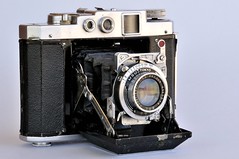 Mamiya Six I |
 Mamiya Six Ia |
 Mamiya Six II |
 Mamiya Six IIa |
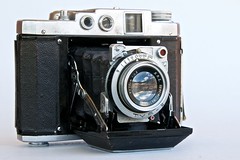 Mamiya Six III |
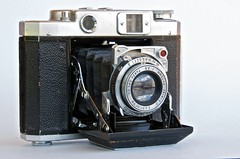 Mamiya Six IV |
 Mamiya Six V |
 Mamiya Six IVb |
 Mamiya Six IVs |
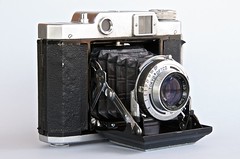 Mamiya Six K |
 Mamiya Six K2 |
 Mamiya Six P |
 Mamiya Six Automat |
 Mamiya Six Automat 2 | ||
| Mamiya Six Model I sn# 2854 with K.O.L. Anastigmat 75mm f/3.5 in MSU-TOKYO NEW HIT shutter. Images by Dirk HR Spennemann. (Image rights) | |||
TEMPLATE CHART
| Mamiya Six Chronology () | |||||||||||||||||||||||||||||||||||||||||
|---|---|---|---|---|---|---|---|---|---|---|---|---|---|---|---|---|---|---|---|---|---|---|---|---|---|---|---|---|---|---|---|---|---|---|---|---|---|---|---|---|---|
| pre-War | World War II | post-War | MIOJ | ||||||||||||||||||||||||||||||||||||||
| 1940 | 1941 | 1942 | 1943 | 1944 | 1945 | 1946 | 1947 | 1948 | 1949 | 1950 | 1951 | 1952 | 1953 | 1954 | 1955 | 1956 | 1957 | 1958 | 1959 | ||||||||||||||||||||||
| Six I | |||||||||||||||||||||||||||||||||||||||||
| Six II | |||||||||||||||||||||||||||||||||||||||||
| Six III | ? | Six III | |||||||||||||||||||||||||||||||||||||||
| Six IV | |||||||||||||||||||||||||||||||||||||||||
MIOJ—Made in Occupied Japan
Dichotomous Key to aid identification of models
The Mamiya Six comes in a bewildering range of variants. The following dichotomous key provided below provides an avenue at identifying the types of Mamiya Six. Given the confusing similarity of models and variants, it is recommended that you follow the steps, rather than scanning for criteria. Once you have identified your model, click on the model name to be taken to a full description. If you are unclear about one of the criteria, either click on the name or scroll down to the bottom of the page for visual identification guides.
| START : How many viewfinder windows are on the front? |
TWO Windows
|
THREE Windows
|
Patent Application
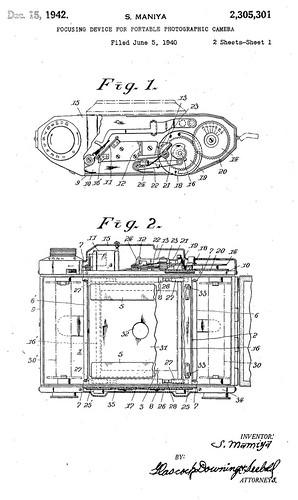 |
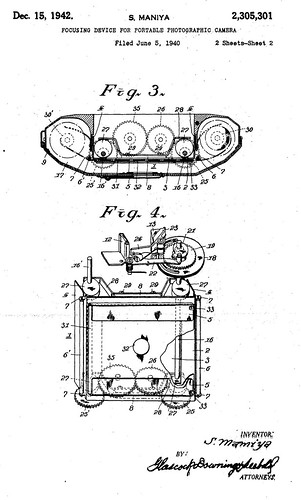 |
| Illustrations accompanying Seiichi Mamiya's Patent application for the Mamiya Six focussing system Images by Dirk HR Spennemann. (Image rights) | |
Notes
- ↑ Mamiya. A History of Innovation. Mamiya 50th Anniversary. Produced by the Mamiya-History of Innovation Editorial Committee. Bunkyo-ku, Tokyo: Mamiya Camera Co. Ltd. p.
- ↑ Which was granted in October 1940: <Mamiya. A History of Innovation. Mamiya 50th Anniversary. Produced by the Mamiya-History of Innovation Editorial Committee. Bunkyo-ku, Tokyo: Mamiya Camera Co. Ltd. p. iii
- ↑ Focussing Device for Portable Photographic Cameras. Patent application by Seiichi Mamiya, Ohita, Takata-Gun, Japan. Filed 5 June 1940, granted 15 December 1942. U.S. Patent nº 2,305,301.
- ↑ According to the official Mamiya history website | History of Mamiya Six (Mamiya history website)
- ↑ See the lens chronology on the Zukio page.
PAGE TWO -- Mamiya Six I
The development of the camera production followed immediately after the formation of Mamiya Kōki Seisakusho (マミヤ光機製作所, Mamiya Optical Works) in May 1940.[1] First advertised in Asahi Camera in September 1940[2] the camera went on sale in December 1940 at a price of ¥248[3] According to company history, the first production of 61 cameras sold out on the first day, with orders for 250 additional units received.[4]The Mamiya Six was designed with both the domestic and the export market in mind and was heavily promoted at Japanese Export trade affairs in Japan and abroad.[5]

|
| Double exposure warning mark in viewfinder of a Mamiya Six I Images by Dirk HR Spennemann. (Image rights) (Image rights) |
Technical details
- Full metal body construction. Body, back door and front door are made from painted sheet metal, while tip and bottom plate are made from ¶¶¶. The struts supporting the front door are chromed and shows the Mamiya logo. All units are covered with black-brown leatherette with exposed chrome top housing and bottom-plate. The Mamiya logo is embossed in the leatherette of the front door, while 'Mamiya-Six' is embossed on the back door, underneath the red window, which has a horizontal slider opening to the left. The camera has a twin set of range finder windows as well as a small, seperate Brillant-type waist-level viewfinder, resulting in three windows at the front.
- The first model of the camera has a slightly larger waist level viewfinder (12 x 12 mm) than the subsequent models. The round viewfinder window on the front has a serrated edge to it, while it is smooth on the later models. Model I is the only Mamiya Six design with small eyelets for a neck strap. Other characteristics are: a solid knurled film winding knob, a raised button (on the top plate) to release the front door; indicator arrow next to the film counter is a pointed arrow with a thin tail; the shutter release button has a rounded top; the cold shoe for the flash is affixed with three screws; the depth of field indicator at the right corner of the top housing ranges from 3.5 to 8; a bottom plate with a strengthened, raised tripod mount held by three screws and flanked by two knobs for the release of the film spools.
- The back door is hinged at the right. The camera takes 120 roll film and gives 6x6 negatives. The supply chamber is on the right and the take up spool on the left. To ensure that the film remains flat even though the film plane moves in and out with the back focussing mechanism, the Mamiya Six I has a removable pressure plate that slides in from the right. The guide rail for the removable pressure plate runs for the length of the film gate and lacks an embossed directional arrow.
- Some units of the Mamiya Six I have a double exposure warning system,[6] comprised of a small transparent, square, red coloured half-pane that appears in the rangefinder window when the shutter button on the top plate has been pressed[7]
Dimensions
- 140 x 103 x 51mm closed (105mm open), weight 780g.[8]
Lens and shutter combinations
- Interestingly, Mamiya offered purchasers to bring their own lenses, which would be installed in the '0' shutters. This resulted in a range of known shutter combinations:
- K.O.L. Anastigmat 75mm f/3.5
- K.O.L. Special f/3.5 75mm
- K.O.L. Trio f/3.5 75mm
- in ??OD. P. II (T, B, 1-300th) shutter[15]
- Kolex Anastigmat f/3.5 75mm
- in DABIT-SUPER (B, 1-500th) shutter[16]

|

|
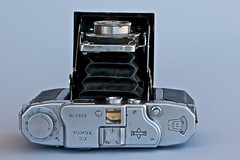
|

|
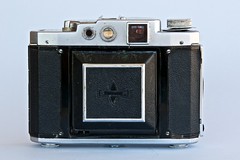
|
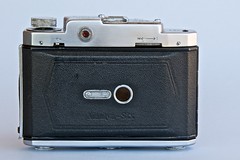
|
| Mamiya Six Model I sn# 2854 with K.O.L. Anastigmat 75mm f/3.5 in MSU-TOKYO NEW HIT shutter. Images by Dirk HR Spennemann. (Image rights) | ||
Mamiya Six Ia
The next iteration, publicised in January 1941[17] saw the use of a larger '00' shutter, which required the redesign of the strut system. Instead of the three-part struts, the camera has a simple, two-part strut mechanism. [18] The camera sold for ¥298.
Technical details
- All units are covered with leatherette. The camera has a slightly larger waist level viewfinder (12 x 12 mm) than the subsequent models. The film respool knob is a solid knurled knob. The indicator arrow next to the film counter is a pointed arrow with a thin tail. The larger diameter shutter required that the internal door catch be designed and there is a different shape to the shutter release side of the front door.
Dimensions
- 140 x 103 x 51mm (closed), weight 780g.
Lens and shutter combinations
- K.O.L. Special 75mm f3.5
- in ¶¶¶ '0' shutter with T, B, 1-1/200 sec (standard)
Manuals, Brochures and Advertisements
 English-language Instruction Sheet (insert to the Japanese set) |
 Advert Asahi Camera (アサヒカメラ) April 1941, p.584. |
http://TEXT.jpg Advert in TEXT |
http://TEXT.jpg Advert in TEXT |
| Pre-War instruction sheets and advertisements for the Mamiya Six I Images by Rebollo_fr. (Image rights) | |||
Notes
- ↑ Mamiya. A History of Innovation. Mamiya 50th Anniversary. Produced by the Mamiya-History of Innovation Editorial Committee. Bunkyo-ku, Tokyo: Mamiya Camera Co. Ltd. p. 3.
- ↑ Asahi Camera September 1940 | Neco's Mamiya page
- ↑ | Mamiya Six I (Mamiya history website).—See also advertisement in Asahi Camera (アサヒカメラ) April 1941 (Rebollo_fr flickr).—By December 1941 the Mamiya Six I sold for ¥298 ('Mamiya. A History of Innovation. Mamiya 50th Anniversary. Produced by the Mamiya-History of Innovation Editorial Committee. Bunkyo-ku, Tokyo: Mamiya Camera Co. Ltd. p.4).
- ↑ Mamiya. A History of Innovation. Mamiya 50th Anniversary. Produced by the Mamiya-History of Innovation Editorial Committee. Bunkyo-ku, Tokyo: Mamiya Camera Co. Ltd. p. 3.
- ↑ According to company history, the Mamiya Six was taken on a Japanese export mission to Latin America (in December 1940) as a representative example of the Japanese camera industry (aboard the Osaka Shoshen Kaisha passenger-cum-cargo vessel Montevideo Maru). The Mamiya Six also won first prize at the Tokyo Export Promotion fair in April 1941: Mamiya. A History of Innovation. Mamiya 50th Anniversary. Produced by the Mamiya-History of Innovation Editorial Committee. Bunkyo-ku, Tokyo: Mamiya Camera Co. Ltd. p. 3
- ↑ At least from sn#28xx onwards
- ↑ It is coupled with the shutter button on the top plate; thus releasing the shutter at the shutter face will not trigger the mechanism.— For appearance in viewfinder see [| here] (Flickr Image); sn #2854 Photographica Collection Dirk HR Spennemann
- ↑ With K.O.L. Anastigmat 75mm f/3.5 in MSU-TOKYO NEW HIT shutter
- ↑ sn# 2854.—Photographica Collection Dirk HR Spennemann (Flickr image)
- ↑ [[ http://neco.aki.gs/neco99/neco30/00/mamiya/01/010042.html |Neco's Mamiya Site]]
- ↑ [[ http://neco.aki.gs/neco99/neco30/00/mamiya/01/010030.html |Neco's Mamiya Site]]
- ↑ [[ http://neco.aki.gs/neco99/neco30/00/mamiya/01/010020.html |Neco's Mamiya Site]]
- ↑ [[ http://neco.aki.gs/neco99/neco30/00/mamiya/01/010010.html |Neco's Mamiya Site]]
- ↑ [[ http://neco.aki.gs/neco99/neco30/00/mamiya/03/031111.html |Neco's Mamiya Site]]
- ↑ Advertisement in Asahi Camera (アサヒカメラ) April 1941 Rebollo_fr flickr
- ↑ [[ http://www.market4free.com/classifieds/ads/for-sale/photo-video/5918012%7CSales advertisement, seen December 2010]]
- ↑ Asahi Camera January 1941, February 1941 | Neco's Mamiya page
- ↑ | Mamiya Six Ia (Mamiya history website)
PAGE THREE -- Mamiya Six II
The camera was introduced in 1941 and sold for ¥384.[1] [2] Even though numbered Mamiya II, this is in fact the third model to have been introduced. Like the Mamiya Six Ia, this model has a red double exposure warning pane in the rangefinder window. The Mamiya Six II is essentially a Mamiya Six III design without the flash contacts. At least some of the units seen also lack the red double-exposure warning pane in the rangefinder. Thus, in common it also has the slightly smaller waist level viewfinder (10 x 10 mm) and a smooth rim to the central viewfinder window.
Technical details
- Like the Mamiya Six III from which this model is derived, the Six II has a smaller waist level finder (10 x10 mm) and the dimpled shutter release button. The guide rail for the removable pressure plate runs for the length of the film gate and now exhibits an embossed directional arrow.
Dimensions
- TEXT TEXT TEXT
145 x 107 x 53mm (105mm open); 783g [3]
Lens and shutter combinations

|
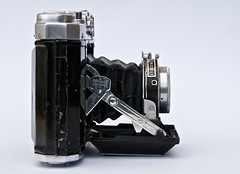
|
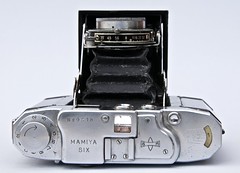
|
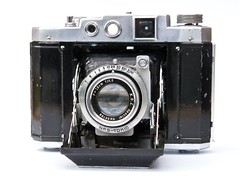
|
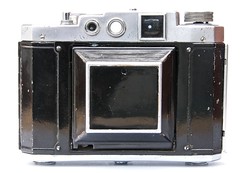
|
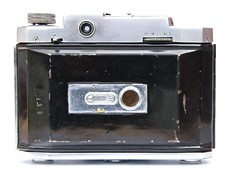
|
| Mamiya Six Model II sn#9518 with a K.O.L. Special 75mm f/3.5 in NKS–TOKIO '0' shutter with T, B, 1-1/200 sec. Images by Dirk HR Spennemann. (Image rights) | ||
Mamiya Six IIa
As with the Mamiya Ia, this version of the Mamiya II allowed to use the larger (58mm) shutters, which required to use a simplified two-strut mechanism for the front door. This version was designed for photographers who wished to have faster (and thus usually larger diameter) shutters or have their own shutter and lens combinations installed.[6]
Dimensions
- 145 x 108 x 53 mm closed (105mm open); weight:827g[7]
Lens and shutter combinations
- K.O.L. Special f/3.5 75mm
- in WESTER-MODEL-I shutter (T, B, 1-200th)[8]
- T.S.M. Anastigmat f/3.5 75mm
- Carl Zeiss Jena Tessar f/2.8 7.5cm

|

|

|
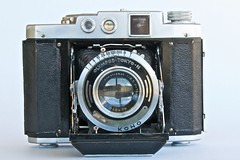
|
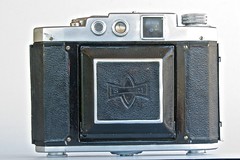
|

|
| Mamiya Six Model IIa sn# 22344 with T.S.M. Anastigmat f/3.5 75mm in OLYMPUS-TOKYO-N KOHO shutter (B, T, 1-200th). Images by Dirk HR Spennemann. (Image rights) | ||
Brochures and Manuals
| http://XXXX.jpg | http://XXXX.jpg | http://XXXX.jpg | http://XXXX.jpg |
| 'War-Time 'Advertising Brochure' (selective pages only) Images by Dirk HR Spennemann. (Image rights) | |||
Notes
- ↑ Mamiya. A History of Innovation. Mamiya 50th Anniversary. Produced by the Mamiya-History of Innovation Editorial Committee. Bunkyo-ku, Tokyo: Mamiya Camera Co. Ltd. p.4
- ↑ Asahi Camera ¶¶¶¶¶ | Neco's Mamiya site
- ↑ With a K.O.L. Special 75mm f3.5 in NKS–TOKIO '0' shutter with T, B, 1-1/200 sec
- ↑ sn# 9518.—Photographica Collection Dirk HR Spennemann | (Flickr image)
- ↑ sn#19513—Photographica Collection Dirk HR Spennemann
- ↑ Mamiya History Pages, | Mamiya Six IIa
- ↑ With a T.S.M. Anastigmat f/3.5 75mm in OLYMPUS-TOKYO-N KOHO shutter (B, T, 1-200th)
- ↑ Illustrated on the back panel of a Brochure (1943?) on the Mamiya Six III
- ↑ sn#22344—Photographica Collection Dirk HR Spennemann
- ↑ | Neco's Mamiya Site
PAGE FOUR -- Mamiya Six III
Mamiya Six Model III is unique inasmuch as its straddles World War II. Announced in March 1940, [1] before the outbreak of the Pacific War, the camera was produces as long as possible until the factory had to be moved from Tokyo in March 1945. Because the Mamiya Six seems to have been the first camera to have been ordered by the Central Purchasing Office of SCAP,[2] full scale production of the Mamiya Six III resumed in January 1946, when 46 units were delivered.[3]
War-time version
The camera was announced in February 1941[4] and introduced to the market in ¶¶ 1942[5] During the war, production volumes seem to have increased, twice necessitating an enlargement of the factory, first in February 1942 and then again in February 1944[6] In March 1944, Mamiya opened a secondary production facility at Tokyo University for the grinding and assembly of lenses.[7] The production of the Mamiya Six III was halted in March 1945, when the Mamiya factory had to be relocated from Tokyo to the intensified U.S. bombing raids.[8]
Technical details
Like the Mamiya I, the camera was fitted with a double exposure warning system, comprised of a small transparent, red coloured half-pane that would appear in the rangefinder window. At least the post war version has a shutter release lock that prevented accidental double exposure.[9] Double exposure warning mark in viewfinder. Flash contact.
- The Pre-War Versions of the Mamiya Six III are built-identical with the Mamiya Six I, but have a slightly smaller waist level finder (10 x10 mm) window on the top late, while the round viewfinder window on the front has a smooth edge. The shutter release button now has a slight depression (dimple) in the top and the frame counter is encased in the shape of a droplet. The guide rail for the removable pressure plate runs for the length of the film gate and now exhibits an embossed directional arrow. The eyelets for a neck strap, which had been part of the Mamiya Six I design, have been omitted.
Dimensions
- 145 x 107 x 55 mm closed (107 mm open) ; weight: 820g[10]
Lens and shutter combinations

|
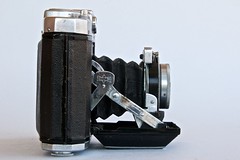
|
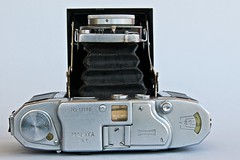
|
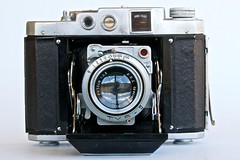
|
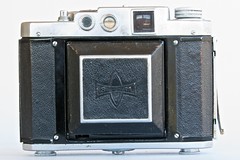
|
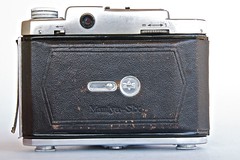
|
| War-time version of the Mamiya Six Model III with K.O.L. Special f/3.5 75mm in TYS -II (B, T, 1-200th) shutter. Images by Dirk HR Spennemann. (Image rights) | ||
Post war versions
Immediately after Japan's surrender, Mamiya sought to return to Tokyo and recommence camera production. This was facillitated in October 1946 by a major order placed by the Central Purchasing Office of SCAP. When production restarted after the war, some examples of the Mamiya Six III may well have assembled been from spare parts. Soon after, however, new bodies were machined, which have slight design variations compared with the pre-War and War-time bodies (→ technical details). These post-war versions can most readily be distinguished by the use of Takatiho Tokio Zuiko f/3.5 75mm lenses; these lenses, which were later replaced with Olympus Zuiko badged versions, were designed in post-World War II and first released in 1946.[19]. Full production recommenced in January 1946, when the first 57 units were delivered. Additional orders were placed by the Japan Trade Agency for bartered exports.[20] An English language manual for the Mamiya Six with a printing date of November 1946 depicts a Mamiya Six III but does not give much additional detail regarding lenses.[21] The fact that so far far no Mamiya Six III units have been noted which carry the engraving "Made in Occupied Japan" on the bottom, suggests that the production of the Mamiya Six III halted before the issuance of SCAPIN 1535 in February 1947.[22] Yet, advertising for the camera continued until December 1947 (→ Advertisements). Either these were surplus stocks, or units inscribed with Made in Occupied Japan have gone unpublicised.
Technical details
- Post War versions of the Mamiya Six III are very similar to the prewar versions. They have a cold shoe for the flash which is affixed by two screws set diagonally; and a depth of field indicator ranging from 3.5 to 22. The encased, more elaborate droplet shaped frame counter of the war-time versions is replaced by a simple broad arrow.[23] The film winding knob is now mush-room-shaped. The directional arrow at the focus wheel has a filled head and only shows infinity as a direction. Minor differences are a stronger internal door catch and a different shape to the shutter release side of the front door. In addition, the protruding tripod socket is a slightly flatter than the pre-war models.
Variant A
- single raised button to release the front door catch
Variant B
- twin buttons to release the front door catch
Dimensions
- 146 x 108 x 50mm closed (106 open); weight: 827g[24]
Lens and shutter combinations
- Nippon Kogaku Nikkor f/3.5 75mm
- Takatiho Tokio Zuiko f/3.5 75mm
- Tōwa Kōki Neocon f/3.5 75mm (July 1947— )
- T.S.M. Anastigmat f/3.5 75mm
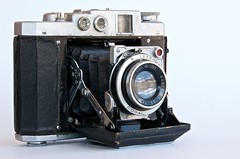
|

|
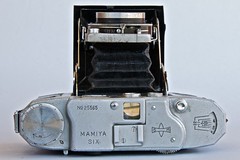
|

|
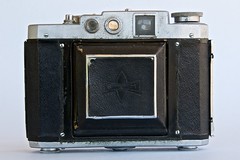
|

|
| Post-war version of the Mamiya Six Model III with Tōwa Kōki Neocon f/3.5 75mm in COPAL (B, 1-300th) shutter. Images by Dirk HR Spennemann. (Image rights) | ||
  
|
  
|
| Post-war version of a Mamiya Six III no.23875, COMPUR shutter (T, B, 1–300), Nikkor 7.5cm f/4.5 lens no.75183. Pictures courtesy of eBayer badman664. (Image rights) |
Brochures and Manuals
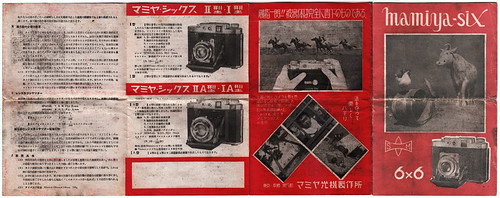
|
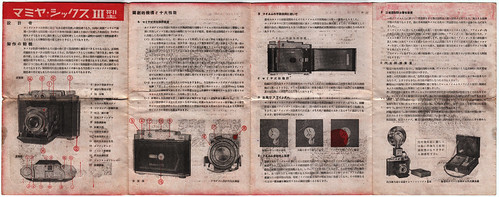
|
| War-Time Brochure for the Mamiya Six III (with reference to the Mamiya Six I, IA, II and IIA) Images by Dirk HR Spennemann. (Image rights) | |

|
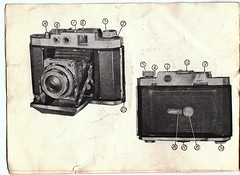
|
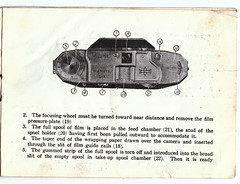
|
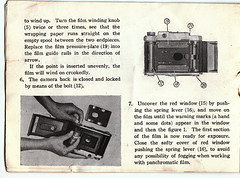
|
| Post-War instruction Booklet for the Mamiya Six III (selective pages only) Images by Dirk HR Spennemann. (Image rights) | |||
Advertisements
 Advert by Kōseisha in Shashin Kagaku (写真科学) Jan 1944 |
 Advert by Nisshindō in Shashin Kagaku (写真科学) Jan 1944 |
 Advert by Nihon Diamond in Shashin Kagaku (写真科学) Jan 1944 |
 Advert in Nihon Shashin (日本写真) Jan-Feb 1944 |
 Advert by Kōseisha in Shashin Kagaku (写真科学) Jan 1944 |
 Advert by Nihon Diamond in 'Shashin Kagaku (写真科学) Feb & Jul 1944 |
 Advert by Matsuzakaya in Shashin Kagaku (写真科学) Jan-Feb 1944 |
 Advert by Hongō Shinbidō in Shashin Kagaku (写真科学) Jan-Feb 1944 |
 Advert by Asanuma Shashinki-ten in Nihon Shashin (日本写真) May 1944 |
 Advert in Nihon Shashin (日本写真) May 1944 |
 Advert by Kōseisha in Shashin Kagaku (写真科学) Jul 1944 |
 Advert in Nihon Shashin (日本写真) Jul 1944 |
| Pre-War and war-time advertisements for the Mamiya Six III Images by Rebollo_fr. (Image rights) | |||
 Ars Camera Feb 1946 |
 Ars Camera Jul 1946 |
 Ars Camera Apr 1946 |
 Ars Camera Nov-Dec 1946 |
| http://XXXX.jpg | http://XXXX.jpg | http://XXXX.jpg | http://XXXX.jpg |
 Ars Camera Jan 1947 |
 Ars Camera Feb 1947 |
 Ars Camera Mar 1947 |
 Ars Camera Apr 1947 |
 Ars Camera Oct 1947 |
 Kohga Gekkan (光画月刊). Dec 1947 | ||
| Post-War advertisements for the Mamiya Six III Images by Rebollo_fr. (Image rights) | |||
Notes
- ↑ Mamiya. A History of Innovation. Mamiya 50th Anniversary. Produced by the Mamiya-History of Innovation Editorial Committee. Bunkyo-ku, Tokyo: Mamiya Camera Co. Ltd. p. 3
- ↑ Supreme Command of the Allied Powers in Japan
- ↑ Mamiya. A History of Innovation. Mamiya 50th Anniversary. Produced by the Mamiya-History of Innovation Editorial Committee. Bunkyo-ku, Tokyo: Mamiya Camera Co. Ltd. p. 4
- ↑ Mamiya. A History of Innovation. Mamiya 50th Anniversary. Produced by the Mamiya-History of Innovation Editorial Committee. Bunkyo-ku, Tokyo: Mamiya Camera Co. Ltd. p. 3.
- ↑ Asahi Camera ¶¶¶¶¶ | Neco's Mamiya page
- ↑ The tripling in size (Mamiya. A History of Innovation. Mamiya 50th Anniversary. Produced by the Mamiya-History of Innovation Editorial Committee. Bunkyo-ku, Tokyo: Mamiya Camera Co. Ltd. p. 4).
- ↑ Mamiya. A History of Innovation. Mamiya 50th Anniversary. Produced by the Mamiya-History of Innovation Editorial Committee. Bunkyo-ku, Tokyo: Mamiya Camera Co. Ltd. p. 4.—At this point of the research it is not clear whether the lenses manufactured at Tokyo University carried a different nomenclature.
- ↑ Mamiya. A History of Innovation. Mamiya 50th Anniversary. Produced by the Mamiya-History of Innovation Editorial Committee. Bunkyo-ku, Tokyo: Mamiya Camera Co. Ltd. p. 4.
- ↑ Intentional double exposure was possible by pushing the film advance lock to the left, but not advancing the film
- ↑ With K.O.L. Special f/3.5 75mm in TYS -II (B, T, 1-200th) shutter
- ↑ [[ http://neco.aki.gs/neco99/neco30/00/mamiya/03/0300500.html |Neco's Mamiya Site]]
- ↑ [[ http://page4.auctions.yahoo.co.jp/jp/auction/d110780810 November 2010)|Yahoo Auction, seen December 2010]]
- ↑ [[ http://neco.aki.gs/neco99/neco30/00/mamiya/03/031112.html |Neco's Mamiya Site]]
- ↑ [[ http://neco.aki.gs/neco99/neco30/00/mamiya/03/03111c.html |Neco's Mamiya Site]]
- ↑ [[ http://neco.aki.gs/neco99/neco30/00/mamiya/03/031114.html |Neco's Mamiya Site]]
- ↑ [[ http://neco.mediacat-blog.jp/c2702_2.html |Neco's Mamiya Site]]
- ↑ sn#17170—Photographica Collection Dirk HR Spennemann
- ↑ [[ http://www.flickr.com/photos/garww/2092718840/in/pool-998914@N24/%7CFlickr image]]
- ↑ See the lens chronology on the Zukio page.
- ↑ Mamiya. A History of Innovation. Mamiya 50th Anniversary. Produced by the Mamiya-History of Innovation Editorial Committee. Bunkyo-ku, Tokyo: Mamiya Camera Co. Ltd. p. 4.
- ↑ Photographica Collection Dirk HR Spennemann
- ↑ See the entry Made in Occupied Japan for background.
- ↑ In essence the design goes back to that of the Mamiya I.
- ↑ With Tōwa Kōki Neocon f/3.5 75mm in COPAL (B, 1-300th) shutter
- ↑ [[ http://www.flickr.com/photos/rebollo_fr/3625576602/in/pool-46195334@N00/%7CFlickr image]]
- ↑ [[ http://picasaweb.google.com/kheims/CraigslistAndEbay#5356646212296282242%7CWeb page]]
- ↑ sn#24763—Photographica Collection Dirk HR Spennemann
- ↑ [[ http://neco.aki.gs/neco99/neco30/00/mamiya/03/03111g.html |Neco's Mamiya Site]]
- ↑ [[ http://neco.aki.gs/neco99/neco30/00/mamiya/03/03111b.html |Neco's Mamiya Site]]
- ↑ sn#25585—Photographica Collection Dirk HR Spennemann
- ↑ [[ http://nelsonfoto.com/SMF/index.php?action=printpage;topic=12471.0%7CWeb page]]
- ↑ [[ http://neco.aki.gs/neco99/neco30/00/mamiya/03/03111a.html |Neco's Mamiya Site]]
- ↑ [[ http://www.auctiondeals.ca/detail_product/150470493227/mamiya_six/%7CSales advertisement, seen December 2010]]
- ↑ [[ http://senior.nikkosen.net/cameralist.html |Web page]]
PAGE FIVE -- Mamiya Six IV
The camera was introduced in ¶¶ 1947.[1] It was a major redesign of the camera, dispensing with the small waist-level viewfinder. That space was take up by a newly designed range-finder mechanism, which had been developed by Mamiya in March 1947.[2]
As part of the export drive, managed by the U.S. administration, Mamiya cameras were sold overseas in large quantities.[3] Once such contract was the manufacture of Mamiya Six IV models for the Indian distributor Patel. These units were badged CAMEX Six.
The camera was sold for ¥ ¶¶¶ in Japan.[4]
A certain black-market trade (by servicemen stationed in Japan) seems to have existed in countries where formal imports did not occur until later.[5]
It is listed in Australia for £24 10s in 1952[6]
and the USA for $99.95 in 1954[7]
Technical details
- TEXT TEXT TEXT
- In keeping with the directives of the U.S. administration of Japan, Mamiya cameras produced between 1947 and 1949 were marked " Made in Occupied Japan." The early variants had this statement prominently engraved into bottom of the metal housing, but the later production was allowed to use text embossed into the leather covering of the door catch.[8]
Variant A
- The inscription "Made in Occupied Japan" is engraved on the bottom plate.
Variant B
- The inscription "Made in Occupied Japan" is embossed into the leatherette of the door closing mechanism..
Variant C
- The camera no longer exhibits any reference to "Made in Occupied Japan".
CAMEX Six
- In 19¶¶ Mamiya signed a major export order with the Indian distributor Patel. A large number of custom-badged Mamiya Six IV were produced,[9] carrying on the top housing the engraving "CAMEX SIX PATEL INDIA LTD" instead of the standard 'MAMIYA-6.' In every other aspect these Indian export models are build-identical with standard Six IV models and retain the Mamiya logo both (engraved) on the top housing and (embossed) on the front door.[10]
Dimensions
- TEXT TEXT TEXT
Lens and shutter combinations
Variant A
Variant B
Variant C
CAMEX Six
- Novar Anastigmat f/3.5 75mm
- Olympus D Zuiko F.C. f/3.5 75mm
- Olympus Zuiko C f/3.5 75mm
- Olympus Zuiko Coated f/3.5 75mm
- Olympus Zuiko F.C. f/3.5 75mm
- Setagaya Kōki Sekor T f/3.5 75mm (silver face)
- Takatiho Tokio Zuiko f/3.5 75mm
- Tokyo Opt. Co. C. Simlar f/3.5 75mm
  
|
  
|
| Mamiya Six IV no.35446, Zuiko 7.5cm f/3.5 lens no.38265. Pictures courtesy of Adrian Gotts. (Image rights) |
Advertisements
 Ars Camera May 1948 |
 Asahi Camera (アサヒカメラ) Camera May 1950 |
 Asahi Camera (アサヒカメラ) June 1950 |
 Asahi Camera (アサヒカメラ) Aug 1950 |
 Photo Art (フォトアー) Jan 1951 |
 Asahi Camera (アサヒカメラ) Mar 1951 |
 Asahi Camera (アサヒカメラ) Jul 1951 |
 Asahi Camera (アサヒカメラ) March 1952 |
| http://XXXX.jpg | http://XXXX.jpg | http://XXXX.jpg | |
| Post-War advertisements for the Mamiya Six IV Images by Rebollo_fr. (Image rights) | |||
Notes
- ↑ Asahi Camera ¶¶¶¶¶ Neco's Mamiya page
- ↑ Mamiya. A History of Innovation. Mamiya 50th Anniversary. Produced by the Mamiya-History of Innovation Editorial Committee. Bunkyo-ku, Tokyo: Mamiya Camera Co. Ltd. p. 5.
- ↑ Unlike with the early Konica I models, we do not have any Mamiya Six copies with an engraved CPO [Central Purchasing Office] mark, suggesting that not too many Mamiya cameras were sold in the US PX stores in Japan. ¶¶VERIFY
- ↑ ¶¶¶
- ↑ Mamiya IV (or III?) were sold on the private market in Australia, probably as bring-back items by servicemen stationed in post-World War II Japan. In 1948, the going price seems to have been £50 in both Sydney and Melbourne: Advertising 'Wanted to sell’ The Sydney Morning Herald 13 March 1948 p 13 (private advertisement) with Zeiss Tessar in Compur Shutter £50.—Advertising 'Wanted to sell’ The Argus (Melbourne) 11 February 1948 p 11 col. 2 (private advertisement) £50.
- ↑ Classified Advertising ‘Goodman Bros, Sydney’ The Sydney Morning Herald 10 May 1952 p 14 £24/10/
- ↑ Sales price in the USA in 1954: Mamiya IV with Olympus D Zuiko F.C. f/3.5 (black face) $99.95; Auto-up $18.95; Flash $19.95 (The Complete Photo Equipment Guide. U.S. Camera November 1954, p. 89 file
- ↑ The same, for example, was required on the early Konica I models. But Konica had the statement prominently engraved on the top housing. (see [| this photo].
- ↑ The total number of Mamiya Six IV badged as 'CAMEX' is unclear at the time of writing. Preliminary searches have so far identified the following serial numbers: 41520, 43015, 43043, 43076 and 43122. Because standard versions of the Mamiya Six IV exist with serial numbers in the 42xxx range, it is possible that Mamiya filled at least two orders to India.
- ↑ See images in Sylvian Halgand's site
- ↑ [[ http://www.pbase.com/nickdemarco/image/122732832%7CWeb page]]
- ↑ [[ http://page5.auctions.yahoo.co.jp/jp/auction/e105826102%7CYahoo Auction, seen December 2010]]
- ↑ [[ http://www.pbase.com/jypsee/oldcameras%7CWeb page]]
- ↑ sn#49068—Photographica Collection Dirk HR Spennemann
- ↑ [[ http://www.flickr.com/photos/yefeihe/4909210453/%7CFlickr image]]
- ↑ [[ http://photo.net/medium-format-photography-forum/00H92u%7CWeb page]]
- ↑ sn#71295—Photographica Collection Dirk HR Spennemann
- ↑ [[ http://ota-euphony.sakura.ne.jp/?page_id=78%7CWeb page]]
- ↑ [[ http://page9.auctions.yahoo.co.jp/jp/auction/k135303419%7CYahoo Auction, seen December 2010]]
- ↑ [[ http://www.flickr.com/photos/rebollo_fr/2448145013/in/pool-camerapedia/%7CFlickr image]]
- ↑ sn#36632—Photographica Collection Dirk HR Spennemann
PAGE SIX -- Mamiya Six V
November 1953 Mamiya 6-V Dual format (6x4.5cm and 6x6cm) with automatic film winding adjustment. Maximum shutter speed improved to 1/500 sec.
Technical details
- TEXT TEXT TEXT
Dimensions
- TEXT TEXT TEXT
Lens and shutter combinations
- Kowa Optical Works Prominar f/3.5 75mm
- Olympus D Zuiko F.C. f/3.5 75mm
- Olympus Zuiko F.C. f/3.5 75mm
Notes
PAGE SEVEN -- Mamiya Six K
The Mamiya Six-K was introduced in August 1954 as a popular, lower priced version of Mamiya 6-V. It lacks not only the automatic film winding stop but also lacks the red double exposure warning pane in the viewfinder, which had been a characteristic of the earlier models.
Technical details
The front range finder windows of the Mamiya Six-K resemble those of the Mamiya IV (a round window at the left and a rectangular window on the right, surrounded by a small screwed-on frame). the margins of the frame of the Mamiya Six K are narrower than those of the Mamiya IV.[1] The name tag of the camera is ¶¶¶ The catch for the film door opens upwards, rather than downwards as was the case with the earlier Mamiya Six models.
Dimensions
- TEXT TEXT TEXT
Lens and shutter combinations
- Setagaya Kōki Sekor T f/3.5 75mm (silver face)
- Tokyo Opt. Co Toko f/3.5 75mm (black face)
- in TOKYO OPT CO-badged RECTUS (B, T, 1-200th) shutter[4]
Notes
- ↑ The design has been taken from the Mamiya IV as the Mamiya V has a long a long plate supporting BOTH the circular and the rectangular window.
- ↑ [[ http://neco.aki.gs/neco99/neco30/00/mamiya/031223.html |Neco's Mamiya Site]]
- ↑ [[ http://neco.aki.gs/neco99/neco30/00/mamiya/031224.html |Neco's Mamiya Site]]
- ↑ sn#9616—Photographica Collection Dirk HR Spennemann.—The low serial number for the Mamiya Six K body is rather odd and totally out of sequence. It is quite probably that this is a human manufacturing error (based on the serial number data compiled so far, a number like 39616 is more plausible), or that the numbering for the Mamiya Six K was restarted.—The Lens and shutter combination on the unit is somewhat unusual. The Combination of Toko f/3.5 75mm with Tōkyō Kōgaku RECTUS shutter can be found on the [PrimoFlex IB]. Until more units with this shutter combination come to light, we may have to assume that this is a post-market custom modification.
PAGE EIGHT -- Mamiya Six IVb
May 1955 Mamiya 6-iV B Camera body size and weight were reduced to increase compactness.
??? new rangefinder in this model??
The design by Seiichi Mamiya was applied in Japan on 23 June 1954 and in the USA on 20 June 1955 (granted 24 June 1958).[1]
Technical details
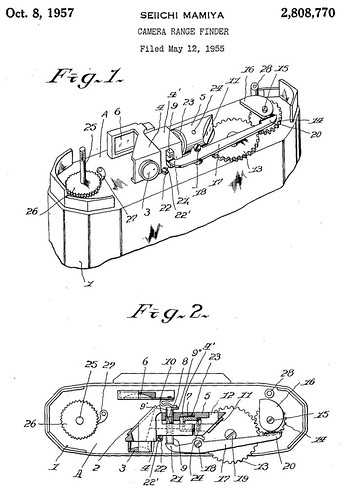
|
| Redesigned rangefinder of the Mamiya Six (US Patent US 2,808,770) (Image rights) |
- TEXT TEXT TEXT
Dimensions
- TEXT TEXT TEXT
Lens and shutter combinations
Notes
- ↑ Camera rangefinder. Patent application by Seiichi Mamiya, Bunkyo-Ku, Tokyo-to, Japan. Filed 12 May 1955, granted 8 October 1957. U.S. Patent nº 2,808,770.
- ↑ [[ http://www.flickr.com/photos/elmoalves/4315236143%7CFlickr image]]
- ↑ [[ http://www.flickr.com/photos/blackfacesheep/5092156263/%7CFlickr image]]
- ↑ [[ http://page2.auctions.yahoo.co.jp/jp/auction/b117574345%7CYahoo Auction, seen December 2010]]
PAGE NINE -- Mamiya Six Automat
December 1955 Mamiya 6-Automat Japan's first automatic shutter cocking by film advancing.
The design by Seiichi Mamiya was applied in Japan on 23 June 1954 and in the USA on 20 June 1955 (granted 24 June 1958).[1]
Technical details
- TEXT TEXT TEXT
Dimensions
- TEXT TEXT TEXT
Lens and shutter combinations
Patent Application
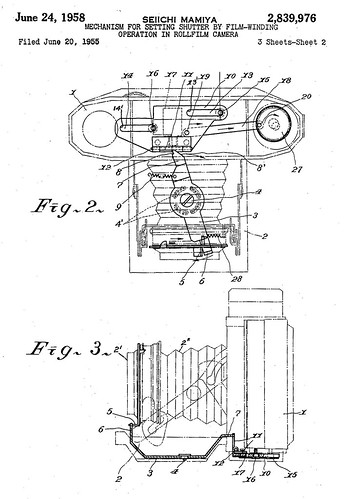 |
 |
| Illustrations accompanying Seiichi Mamiya's Patent application for the Mamiya Six Automat Images by Dirk HR Spennemann. (Image rights) | |
Notes
- ↑ Mechanism for setting shutter by film-winding operation in rollfilm camera. Patent application by Seiichi Mamiya, Bunkyo-Ku, Tokyo-to, Japan. Filed 20 June 1955, granted 24 June 1958 1952. U.S. Patent nº 2,839,976.
- ↑ [[ http://www.g-root.jp/basement/camera/mamiya6automat.html |Web page]]
PAGE TEN -- Mamiya Six K2
March 1956 Mamiya 6-K ii Advanced model to type K with built-in format conversion. (6x6 to 6x4.5cm)
Technical details
- TEXT TEXT TEXT
Dimensions
- TEXT TEXT TEXT
Lens and shutter combinations
Notes
- ↑ [[ http://poyorin.cocolog-nifty.com/blog/2009/09/index.html |Web page]]
- ↑ [[ http://neco.aki.gs/neco99/neco30/00/mamiya/0312510.html |Neco's Mamiya Site]]
PAGE ELEVEN -- Mamiya Six IVs
October 1957 Mamiya 6-iV S Further reduced size and weight from type iV B with addition of built-in self-timer.
Technical details
- TEXT TEXT TEXT
Dimensions
- TEXT TEXT TEXT
Lens and shutter combinations
Notes
- ↑ [[ http://neco.aki.gs/neco99/neco30/00/mamiya/031212.html |Neco's Mamiya Site]]
{{WIP}
PAGE TWELVE -- Mamiya Six P
December 1957 Mamiya 6-P Economy priced version of 6-iV S.
Technical details
- TEXT TEXT TEXT
Dimensions
- TEXT TEXT TEXT
Lens and shutter combinations
- Mamiya Kominar f/3.5 75mm
- Setagaya Kōki Sekor T f/3.5 75mm (silver face)
Notes
- ↑ [[ http://neco.aki.gs/neco99/neco30/00/mamiya/031212.html |Neco's Mamiya Site]]
- ↑ [[ http://neco.aki.gs/neco99/neco30/00/mamiya/20/p/p0200101.html |Neco's Mamiya Site]]
PAGE THIRTEEN -- Mamiya Six Automat 2
1958 Mamiya 6 Automat 2 was the last iteration of the camera design. It was the most highly featured Mamiya 6 camera with Sekor lens, bright Albada finder and other advanced features. Last model of the original folding Mamiya 6 series cameras.
Technical details
- TEXT TEXT TEXT
Dimensions
- TEXT TEXT TEXT
Lens and shutter combinations
- Mamiya Sekor f/3.5 75mm
- Olympus D Zuiko F.C. f/3.5 75mm (black face)
Notes
- ↑ [[ http://neco.aki.gs/neco99/neco30/00/mamiya/031264.html |Neco's Mamiya Site]]
- ↑ [[ http://neco.aki.gs/neco99/neco30/00/mamiya/031271.html |Neco's Mamiya Site]]
PAGE FOURTEEN -- Mamiya Six Design Variations
This page provides a visual overview over the various design elements of the Mamiya Six series of folding cameras. The images have been provided to allow the use an accurate identification of the various models and variants. You are strongly advised to use the dichotomous key provided on the main Mamiya Six page, as this will guide you in the identification of models.
Lenses and Shutters
The Mamiya Six was manufactured in a wide range of lenses and shutters. That holds particularly true for the pre-War and War period, when prospective buyers could even bring in their own shutters and lenses to be fitted. Note that the lens and shutter combinations have been arranged alphabetically, not chronologically.
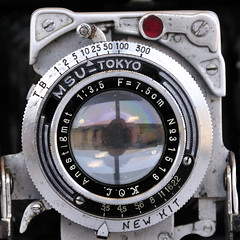 K.O.L. Anastigmat 7.5cm f/3.5 in MSU-TOKYO NEW HIT shutter |
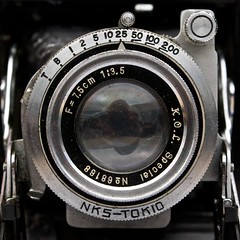 K.O.L. Special 7.5cm f/3.5 in NKS–TOKIO shutter |
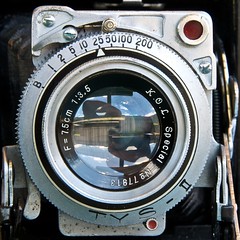 K.O.L. Special 7.5cm f/3.5 in TYS-II shutter |
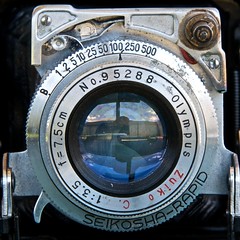 Olympus Zuiko C. f/35. 75mm in Seikosha-Rapid shutter |
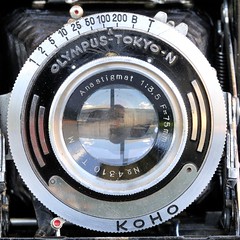 T.S.M. Anastigmat f/3.5 75mm in OLYMPUS-TOKYO-N KOHO shutter |
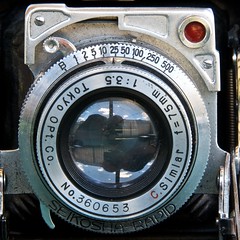 Tokyo Optical Co. C. Simlar f/3.5 75mm in Seikosha-Rapid shutter |
 Tokyo Optical Co.. Toko f/3.5 75mm in Tokyo Opt. Co. RECTUS shutter |
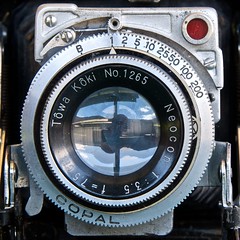 Tōwa Kōki Neocon f/3.5 75mm in Copal shutter |
| Lens and Shutter Combinations of the Mamiya Six. Images by Dirk HR Spennemann. (Image rights) | |||
Flash Contacts
 Type I None, pull-out knob only |
http://XXX.jpg TEXT TEXT |
http://XXX.jpg TEXT TEXT |
http://XXX.jpg TEXT TEXT |
| Appearance of Flash Contacts of the Mamiya Six. Images by Dirk HR Spennemann. (Image rights) | |||
Double Exposure Prevention
 Type I None, pull-out knob only |
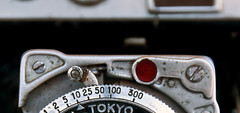 Type II shutter cocked |
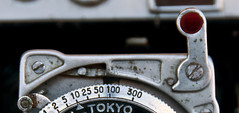 Type II shutter released |
http://XXX.jpg TEXT TEXT |
| Double Exposure Prevention Systems of the Mamiya Six. Images by Dirk HR Spennemann. (Image rights) | |||
Body Shape Variations
Name Plate
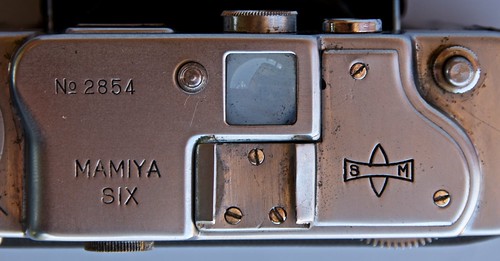 Serial Number to left of flash shoe, above MAMIYA SIX 12x12mm waist view finder (Mamiya Six I) |
 Serial Number to left of flash shoe, above MAMIYA SIX 10x10mm waist view finder (Mamiya Six II, III) | ||
 Serial Number to left of flash shoe, below MAMIYA-6 curved housing, tail of '6' is pointy (Mamiya IV) |
 Serial Number to left of flash shoe, below MAMIYA-6 curved housing, tail of '6' is rounded (Mamiya IV) | ||
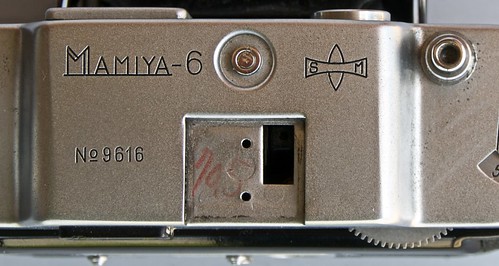 Serial Number to left of flash shoe, below MAMIYA-6 straight housing (Mamiya K) [NOTE the flash shoe is missing] |
http://XXX.jpg TEXT TEXT Serial Number to right of flash shoe | ||
| Nameplate variations of the Mamiya Six. Images by Dirk HR Spennemann. (Image rights) | |||
Rangefinder Windows (front)
| THREE WINDOWS | 
|

| |
 central window with serrated edge |
 central window with smooth edge | ||
| TWO WINDOWS | http://XXX.jpg right window on small plate wide margins top of housing stepped |
http://XXX.jpg right window on small plate narrow margins top of housing sloping |
http://XXX.jpg both windows on a plate top of housing sloping |
| Rangefinder window variations of the Mamiya Six. Images by Dirk HR Spennemann. (Image rights) | |||
Flash Shoe
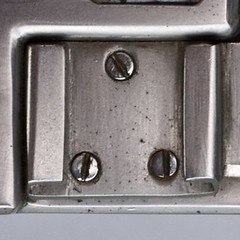 Three screws |
http://XXX.jpg Two screws oblique |
http://XXX.jpg Two screws vertical |
http://XXX.jpg One screw |
| Flash-shoe variations of the Mamiya Six. Images by Dirk HR Spennemann. (Image rights) | |||
Bottom Plate
 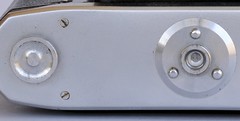 Mamiya Six I, II, III, |
http://XXX.jpg TEXT TEXT |
http://XXX.jpg TEXT TEXT |
http://XXX.jpg TEXT TEXT |
| Appearance of the bottom plate of the Mamiya Six. Images by Dirk HR Spennemann. (Image rights) | |||
Film Counter Window
 Mamiya Six I, II, III, |
http://XXX.jpg TEXT TEXT |
http://XXX.jpg TEXT TEXT |
http://XXX.jpg TEXT TEXT |
| Details of Film Advance Counter (Red) Windows of the Mamiya Six. Images by Dirk HR Spennemann. (Image rights) | |||
Pressure Plate Support
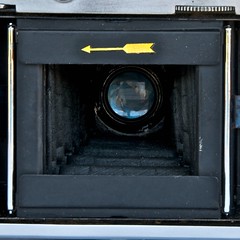 Full length, arrow as label Mamiya Six I, II, III, |
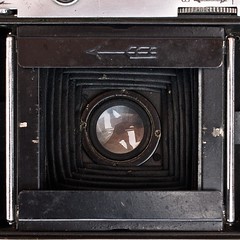 Full length, arrow embossed Mamiya Six II, III, |
http://XXX.jpg TEXT TEXT |
http://XXX.jpg TEXT TEXT |
| Appearance of the guide rail for the removable pressure plate of the Mamiya Six. Images by Dirk HR Spennemann. (Image rights) | |||
Front Door Variations
 Mamiya Six II, III (war-time model) |
http://XXX.jpg Mamiya Six III (post war model), IV, K |

|
http://XXX.jpg |
| Appearance of the front door of the Mamiya Six. Images by Dirk HR Spennemann. (Image rights) | |||
Door Catch Variations
 Mamiya Six II, III (war-time model) |
http://XXX.jpg Mamiya Six III (post war model), IV, K |

|
http://XXX.jpg |
| Appearance of the internal door catch of the Mamiya Six. Images by Dirk HR Spennemann. (Image rights) | |||
Pressure Plate
| http://XXX.jpg | http://XXX.jpg | http://XXX.jpg | http://XXX.jpg |
| http://XXX.jpg TEXT TEXT |
http://XXX.jpg TEXT TEXT |
http://XXX.jpg TEXT TEXT |
http://XXX.jpg TEXT TEXT |
| Appearance of the removable pressure plate of the Mamiya Six. Images by Dirk HR Spennemann. (Image rights) | |||
Various
 Eye-lets for neck strap Mamiya Six I only |
http://XXX.jpg TEXT TEXT |
http://XXX.jpg TEXT TEXT |
http://XXX.jpg TEXT TEXT |
| Various Details of the Mamiya Six. Images by Dirk HR Spennemann. (Image rights) | |||
Knobs and Struts
Film Advance Knob
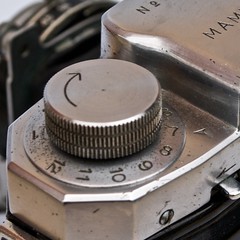 Solid, knurled Knob |
http://XXX.jpg Mushroom-shaped knob |
http://XXX.jpg Mushroom-shaped knob with film speed |
http://XXX.jpg Mushroom-shaped knob with film type |
| Variations of the film advance knob of the Mamiya Six. Images by Dirk HR Spennemann. (Image rights) | |||
Front Door Release
 raised button |
http://XXX.jpg XXX |
http://XXX.jpg XXX |
http://XXX.jpg XXXX |
| Variations of the front door release of the Mamiya Six. Images by Dirk HR Spennemann. (Image rights) | |||
Shutter Release
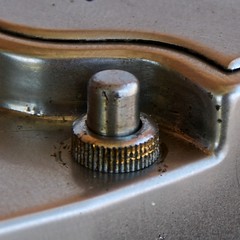 rounded top |
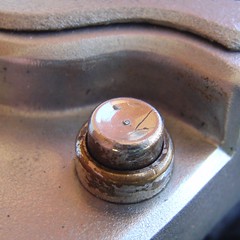 dimpled top |
http://XXX.jpg cable release thred |
http://XXX.jpg XXXX |
| Variations of the shutter release of the Mamiya Six. Images by Dirk HR Spennemann. (Image rights) | |||
Strut Mechanism
 Three Struts ( Standard ) |
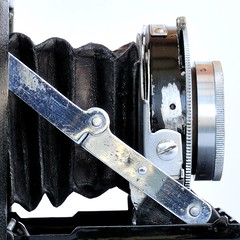 Two Struts ( Mamiya Six Ia & Mamiya Six IIa ) |
http://XXX.jpg TEXT TEXT |
http://XXX.jpg TEXT TEXT |
| The Strut Systems of the Mamiya Six. Images by Dirk HR Spennemann. (Image rights) | |||
Lettering and Labelling
Frame Counter
 Line Arrow |
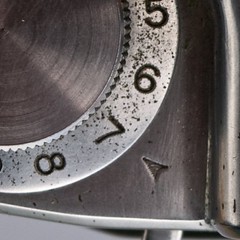 Hollow triangle |
 Hollow broad arrow |
| http://XXX.jpg Filled broad arrow |
http://XXX.jpg Filled triangle |
 Drop-shaped counter |
| Variations of the frame counter of the Mamiya Six. Images by Dirk HR Spennemann. (Image rights) | ||
Depth of Field Indicator
| http://XXX.jpg Demarcation 3.5, 5.6, 8 Distances in Meters Small Arrow |
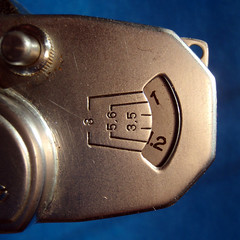 Demarcation 3.5, 5.6, 8 Distances in Meters Spacing: 1, 1.2 (wide) |
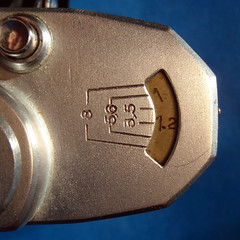 Demarcation 3.5, 5.6, 8 Distances in Meters Spacing: 1, 1.2 (narrow) |
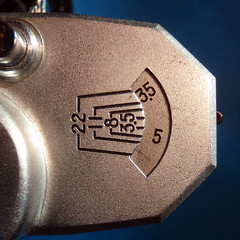 Demarcation 3.5, 8, 11, 22 Distances in Feet Spacing: 3.5, 5 |
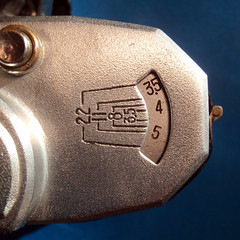 Demarcation 3.5, 8, 11, 22 Distances in Feet Spacing: 3.5, 4, 5 |
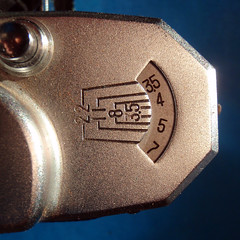 Demarcation 3.5, 8, 11, 22 Distances in Feet Spacing: 3.5, 4, 5, 7 |
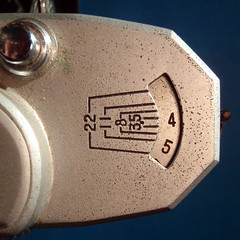 Demarcation 3.5, 8, 11, 22 Distances in Feet Spacing: 4, 5 |
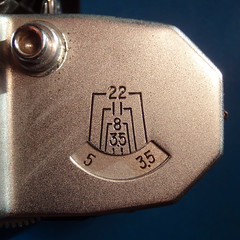 Demarcation 3.5, 8, 11, 22 Distances in Feet 90º turned; spacing: 3.5, 5 |
| Variations of the Depth of Field Indicator of the Mamiya Six. Images by Dirk HR Spennemann. (Image rights) | |||
Film Advance Lock
 Line Arrows |
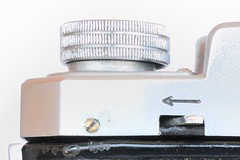 Filled arrows |
http://XXX.jpg Filled arrow, no '1' shown |
| Variations of the labelling of the Film Advance Lock of the Mamiya Six. Images by Dirk HR Spennemann. (Image rights) | ||
Focus Wheel
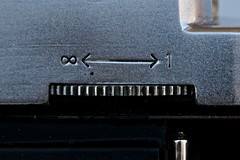 Line Arrows |
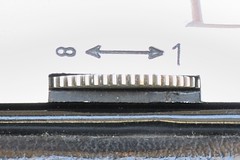 Filled arrows |
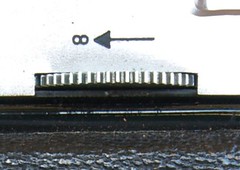 Filled arrow, no '1' shown |
| Variations of the focus wheel of the Mamiya Six. Images by Dirk HR Spennemann. (Image rights) | ||
Made in Japan
| http://XXX.jpg " MADE IN OCCUPIED JAPAN" engraved on the bottom plate |
http://XXX.jpg " MADE IN OCCUPIED JAPAN" embossed in the door latch |
http://XXX.jpg TEXT TEXT |
| Placement of the designator "Made in Occupied Japan" Mamiya Six. Images by Dirk HR Spennemann. (Image rights) | ||
Labels on the Inside
 MAMIYA SIX 6x6 TOKYO NIPPON |
http://XXX.jpg TEXT TEXT |
http://XXX.jpg TEXT TEXT |
| Labels found in the back door of the Mamiya Six. Images by Dirk HR Spennemann. (Image rights) | ||
Leather Cases
The leather cases for the Mmaiya Six were made by suppliers using wooden lasts.[1] Over time modifications in the camera design, as well as changed specifications (e.g. for the case to be opened forward, rather than backward) led to variations in case design.[2]
At present the case seen for the Mamiya Six I is similar to that illustrated for the Mamiya Six III (war time version), except that it lacks all embossing ad that the fastening screw has a simple screw only (and not the characteristic metal bar). The case seen for the Mamiya Six II is again similar, replete with the appropriate cut-out for the red window (under the flap), but the case is embossed 'Zeiss Ikon.'[3]
| TEXT TEXT TEXT | http://XXXX.jpg | http://XXXX.jpg | http://XXXX.jpg | http://XXXX.jpg |
| Mamiya Six III (war time)
Flat case |
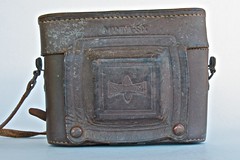
|
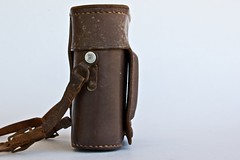
|
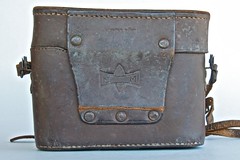
|

|
| Mamiya Six III (post war) Flat case |
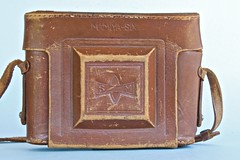
|
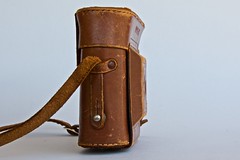
|
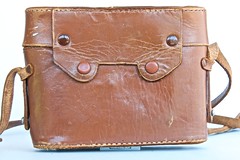
|
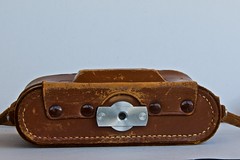
|
| Leather Cases for the Mamiya Six. Images by Dirk HR Spennemann. (Image rights) | ||||
Notes
- ↑ See this blog post for a picture of a last.
- ↑ We need to be conscious that the observations reported here are based cases that came with the cameras. There is a small possibility that in the past a camera was furnished with a different case. This can, and will, be ruled out with a greater sample size.
- ↑ And there is no Zeiss Ikon camera design that has that specific red window configuration. we have to assume that the embossing is a custom job.